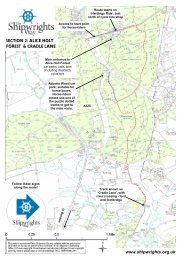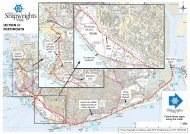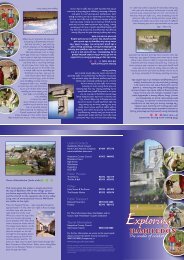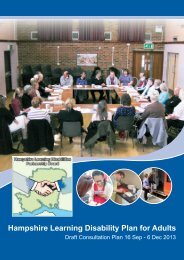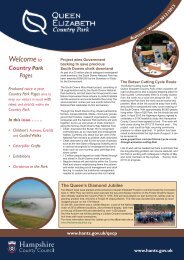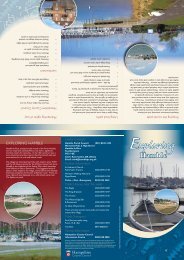Surface Water Management Plan - Hampshire County Council
Surface Water Management Plan - Hampshire County Council
Surface Water Management Plan - Hampshire County Council
You also want an ePaper? Increase the reach of your titles
YUMPU automatically turns print PDFs into web optimized ePapers that Google loves.
6.2. Future / Potential <strong>Surface</strong> <strong>Water</strong> Flood RiskThere are two key datasets available from the Environment Agency whichassess the potential for surface water flooding, namely the Areas Susceptibleto <strong>Surface</strong> <strong>Water</strong> Flooding and the Flood Map for <strong>Surface</strong> <strong>Water</strong>.The Areas Susceptible to <strong>Surface</strong> <strong>Water</strong> Flooding map was produced in July2009. It was produced using a simplistic modelling technique based on asingle rainfall event, namely a storm with a 1 in 200 chance of occurring in anyyear, highlighting areas that could be affected by surface water flooding withinthree different bandings; less, intermediate and more. It does not take intoaccount buildings, drainage or ground permeability. This map should not beused with base mapping of more than 1:50,000 and is not designed to be adetailed representation of areas that could flood.The Agency produced a more detailed Flood Map for <strong>Surface</strong> <strong>Water</strong>, issued inNovember 2010. This uses a more sophisticated modelling technique basedon a number of different assumptions for ground permeability, drainagecapacity and flow routing around structures. It was created using both a 1:30and 1:200 annual probability and separates the level of flood risk into areasthat could experience flooding in excess of 100mm and 300mm. It should notbe used with base mapping of more than 1:25,000 and is not designed toidentify individual properties at risk.Environment Agency guidance suggests that the Areas Susceptible to <strong>Surface</strong><strong>Water</strong> Flooding (2009) map would be more representative of flooding in areaswhere there is minimal drainage capacity and flat areas with a longer stormduration with the Flood Map for <strong>Surface</strong> <strong>Water</strong> (2010) being more suitable forother areas. However, the Environment Agency has stated that localinformation on flooding should be used to identify the most suitable mappingfor specific locations.Upon analysis of the available flood risk data, the SWMP partners haveagreed that the dataset providing the best representation of potential flood riskin Eastleigh is the 2010 Flood Map for <strong>Surface</strong> <strong>Water</strong>.The 1 in 30 year annual probability surface water flood mapping has beenchosen to assess flood risk as the majority of drainage infrastructure andproperty resilience measures are currently designed to accommodate thisscale of rainfall event. Sites at risk of flooding from 1 in 30 year rainfall eventor less will therefore be prioritised for investigatory work so that those areas atthe highest risk can be considered for future works.<strong>Surface</strong> water flooding arising from 1 in 200 year rainfall event is consideredvery extreme rainfall which exceeds that which is generally designed to becontained within drainage systems. However, it should be modelled in termsof exceedance so that overland flows do not cause property flooding and arerouted away from properties where feasible. This dataset is therefore of mostuse for land-use planning purposes.9




